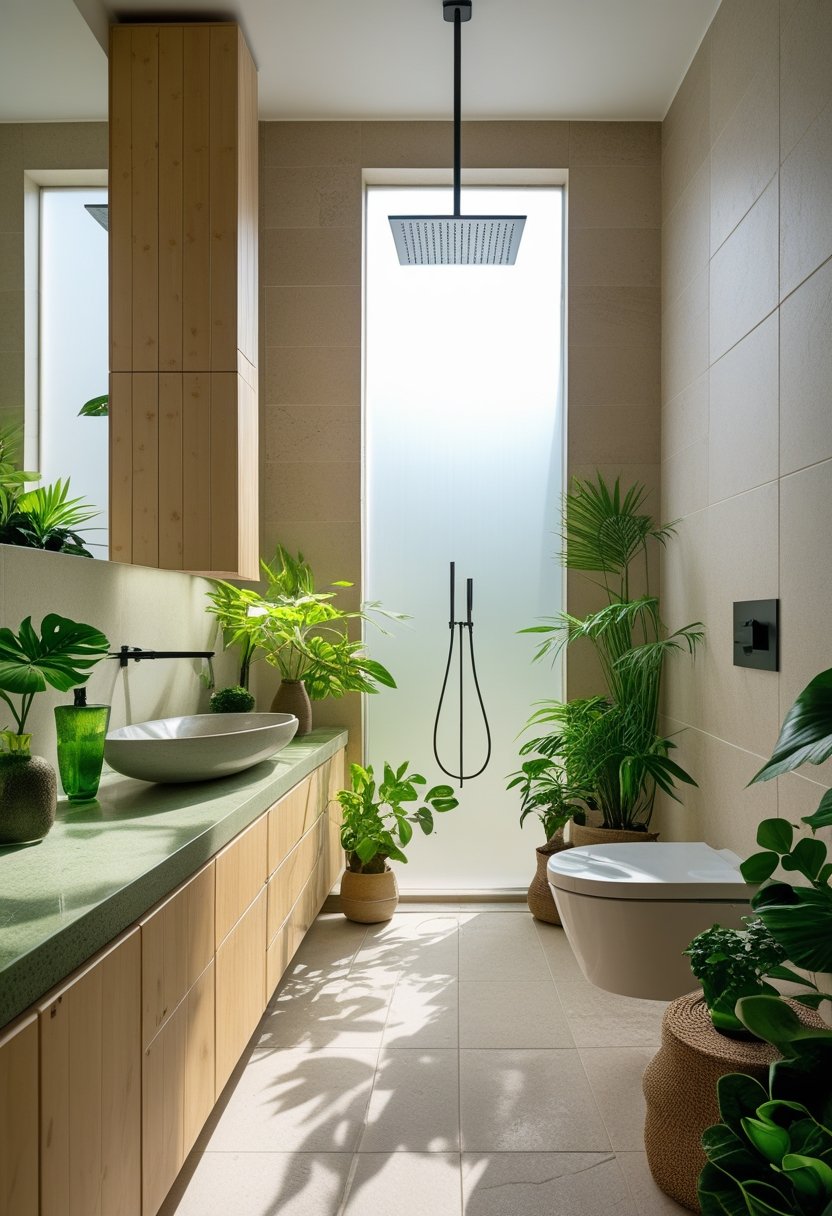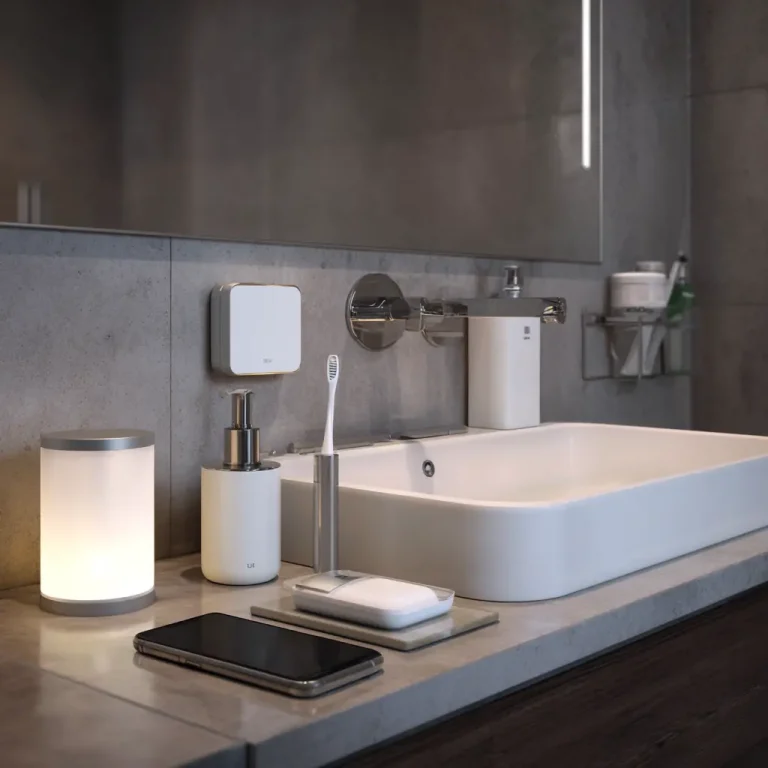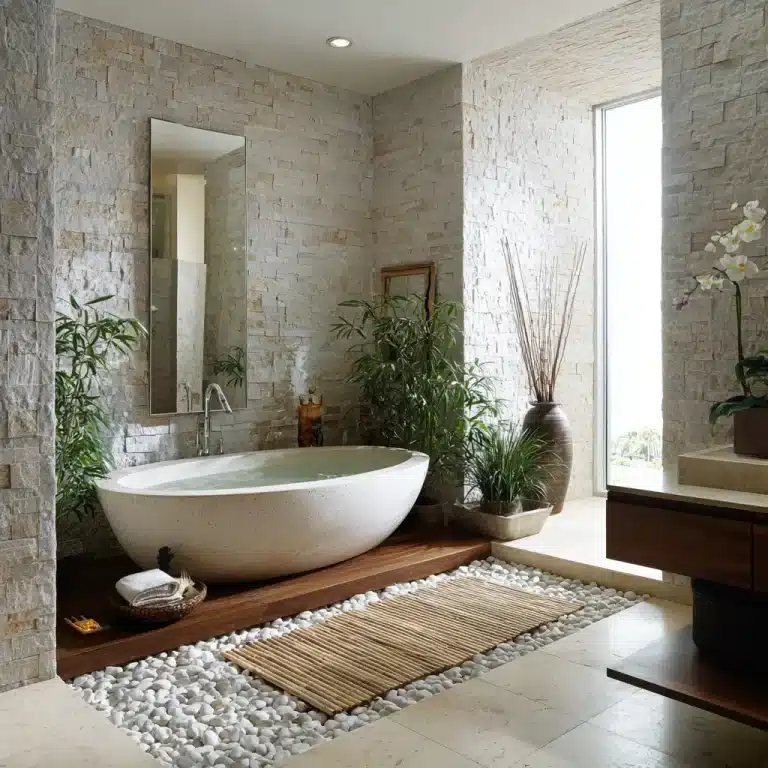18 Terra Futura Eco-Conscious Bathroom Design Ideas for a Sustainable Home

Designing a bathroom today goes beyond style and comfort. People are looking for spaces that reflect both modern living and environmental responsibility. Eco-conscious bathroom design offers practical solutions that save resources while creating a clean, comfortable, and lasting space.

This approach blends sustainable materials, energy-efficient technology, and smart design choices. From natural finishes to advanced water-saving systems, every detail works toward reducing impact without sacrificing function or aesthetics. Terra Futura highlights how these ideas come together, showing that a bathroom can be both sustainable and modern.
1) Sustainable bamboo cabinetry

Bamboo cabinetry offers a renewable option for bathroom storage. It grows quickly and requires fewer resources than many hardwoods.
Its durability makes it practical for daily use in moisture-prone spaces. The natural look also fits well with modern eco-conscious design.
Many homeowners choose bamboo because it balances function, style, and sustainability.
2) Water-saving dual-flush toilets

Dual-flush toilets give users two flush options: a lower volume for liquid waste and a higher volume for solid waste.
This design reduces water use compared to standard single-flush models.
Many modern versions combine efficiency with comfort, making them a practical choice for eco-conscious bathrooms.
3) Recycled glass mosaic tiles

Recycled glass mosaic tiles use repurposed glass to create durable and water-resistant surfaces. They work well for bathroom walls, showers, and backsplashes.
These tiles come in a wide range of colors and finishes, allowing homeowners to add texture and style while making a sustainable design choice.
4) Low-VOC eco-friendly paint

Low-VOC paint reduces harmful emissions, making it safer for indoor air quality. It helps limit exposure to strong odors and chemicals.
These paints come in many finishes and colors, allowing flexibility in bathroom design. They work well for families, people with sensitivities, and eco-conscious homeowners.
5) Solar-powered ventilation fans

Solar-powered ventilation fans use sunlight to power airflow, reducing the need for grid electricity. They help maintain fresh air while lowering energy use.
These fans work well in bathrooms by removing moisture that can lead to mold. Their low maintenance and quiet operation make them a practical eco-friendly choice.
6) Organic cotton bath linens

Organic cotton bath linens use fibers grown without synthetic pesticides or fertilizers. This makes them a safer choice for both people and the environment.
They come in towels, washcloths, and bath mats in many sizes and colors. These linens are durable and soft, fitting well into eco-conscious bathrooms.
7) Smart leak detection systems

Smart leak detection systems use sensors to identify water leaks early. They can send alerts to a phone or connected device.
Some models also shut off the water supply automatically to prevent damage. This helps reduce waste and protects bathroom fixtures.
These systems support eco-conscious design by saving water and improving efficiency.
8) Reclaimed wood shelving

Reclaimed wood shelving adds both function and character to a bathroom. The natural grain and texture create a warm, lived-in look.
It works well with modern or rustic styles, offering storage while reducing waste. Each shelf has unique variations that make the space feel more personal.
9) Energy-efficient LED vanity lighting

LED vanity lights use less electricity than traditional bulbs, which helps reduce energy costs.
They also produce less heat, making them safer and longer lasting in bathroom spaces.
Many options come in modern designs, with adjustable color temperatures to match different needs.
10) Greywater recycling systems

Greywater recycling systems collect water from sinks, showers, or washing machines for reuse.
They often redirect this water for toilet flushing or outdoor irrigation.
By reducing freshwater demand, these systems help conserve resources and lower household water use without major lifestyle changes.
11) Natural clay plaster walls

Natural clay plaster walls provide a breathable and non-toxic finish. They use simple, natural materials that support healthier indoor air.
This type of plaster works well in bathrooms when applied correctly. It resists moisture, adds texture, and creates a calm, natural look.
12) Eco-friendly bamboo flooring

Bamboo flooring offers a renewable option for bathroom spaces. It grows quickly and requires fewer resources compared to traditional hardwood.
Its durability makes it suitable for areas with frequent moisture. Many modern bamboo products also include water-resistant finishes.
The natural look of bamboo adds warmth while supporting sustainable design choices.
13) Biodegradable soap dispensers

Biodegradable soap dispensers use materials that naturally break down over time, such as bamboo or compostable plastics. They reduce long-term waste compared to conventional plastic options.
These dispensers fit well in eco-conscious bathrooms by supporting low-impact living. Choosing certified biodegradable products helps ensure durability while still offering an environmentally responsible option.
14) Touchless sensor faucets

Touchless sensor faucets use infrared or motion sensors to start and stop water flow. This reduces unnecessary water use and helps maintain hygiene.
They prevent direct contact with handles, which lowers the spread of germs. Many models also include water-saving technology that supports eco-friendly bathroom design.
15) Non-toxic grout options

They can choose non-toxic grout to reduce chemical exposure in the bathroom. These products avoid harsh additives and low-quality fillers.
Non-toxic grout comes in a variety of colors and finishes, including modern neutrals and specialty shades. This allows safe design choices without limiting style.
Some options also include low-VOC or zero-VOC formulas. These help improve indoor air quality and support healthier living spaces.
16) Plant-based shower curtains

Plant-based shower curtains use natural fibers such as hemp, organic cotton, or linen. These materials avoid PVC and other plastics often found in traditional curtains.
They provide a simple way to reduce synthetic waste while keeping the bathroom functional. Many options also use non-toxic dyes and water-resistant finishes.
17) Indoor air-purifying plants

They can improve bathroom air quality by reducing common indoor pollutants. Many varieties also thrive in the humidity found in bathrooms.
Plants such as ferns, peace lilies, and snake plants adapt well to low light and moisture. They add greenery while supporting a cleaner indoor environment.
18) Matte black water fixtures

Matte black fixtures add a modern look while pairing well with light or neutral bathroom tones. They create contrast without appearing overly bold.
These fixtures also resist fingerprints and water spots better than shiny finishes, which makes them easier to maintain.
When combined with low-flow technology, they support water conservation while keeping a clean, streamlined style.
Principles of Eco-Conscious Bathroom Design

Eco-conscious bathroom design focuses on reducing environmental impact through material choices, water-saving methods, and energy efficiency. These practices create spaces that are healthier, more durable, and more resource-efficient without sacrificing function or comfort.
Sustainable Material Selection
Choosing the right materials reduces waste and lowers long-term environmental costs. Recycled glass tiles, reclaimed wood vanities, and countertops made from composite stone offer durable options with less impact than traditional choices.
Homeowners often look for FSC-certified wood, low-VOC paints, and bamboo cabinetry. These materials support responsible forestry and improve indoor air quality by limiting chemical emissions.
A simple comparison of common sustainable materials:
| Material | Benefit | Example Use |
|---|---|---|
| Recycled Glass | Diverts waste from landfills | Tiles, counters |
| Bamboo | Rapidly renewable resource | Cabinets, floors |
| Reclaimed Wood | Reduces demand for new timber | Vanities, shelving |
Durability matters as much as sustainability. Materials that last longer reduce replacement needs and prevent excess waste.
Water Conservation Strategies
Bathrooms account for a large share of household water use. Installing low-flow toilets, dual-flush systems, and aerated faucets can cut water consumption by thousands of gallons each year.
Showers also play a big role. Water-saving showerheads use less than 2 gallons per minute compared to older models that use 3–5 gallons. This small change offers both environmental and cost benefits.
Other strategies include:
- Greywater systems for reusing sink or shower water in toilet flushing
- Smart leak detectors to prevent unnoticed waste
- Native plant landscaping near outdoor drains to filter runoff naturally
Together, these steps reduce strain on local water supplies while lowering utility bills.
Energy-Efficient Lighting and Fixtures
Lighting and heating in bathrooms consume more energy than many realize. Switching to LED lighting reduces energy use by up to 80% compared to incandescent bulbs while lasting much longer.
Ventilation fans with Energy Star certification improve air circulation with lower power demand. Heated floors and towel warmers can also be selected in energy-efficient models that use thermostats and timers to avoid unnecessary use.
Key upgrades include:
- LED task lighting around mirrors
- Motion-sensor switches to prevent lights staying on
- Smart thermostats for radiant heating systems
These improvements lower electricity use while maintaining comfort and function in daily routines.
Long-Term Benefits of Eco-Conscious Bathrooms

Eco-conscious bathrooms provide lasting value by improving personal well-being and reducing the strain on natural resources. They also create healthier indoor environments and lower household expenses tied to water and energy use.
Health and Wellness Advantages
Sustainable bathroom design often replaces paints, adhesives, and finishes that contain harmful chemicals with low-VOC or natural alternatives. This reduces indoor air pollution and lowers the risk of respiratory irritation or allergic reactions.
Water-efficient fixtures such as low-flow showerheads and dual-flush toilets help maintain hygiene while cutting water use. These upgrades support both comfort and conservation without sacrificing performance.
Materials like bamboo, recycled glass, or reclaimed wood bring natural textures into the space. Unlike synthetic surfaces, these materials are less likely to off-gas toxins, creating a safer and more pleasant environment.
Better lighting choices also play a role. Energy-efficient LEDs and daylight-focused designs reduce eye strain and create a calming atmosphere that supports relaxation.
Key wellness benefits include:
- Cleaner indoor air quality
- Lower exposure to chemicals
- Improved comfort through natural materials
- Balanced lighting for reduced stress
Environmental Impact Reduction
Bathrooms are among the most resource-intensive rooms in a home. Eco-conscious designs address this by cutting water and energy consumption. For example, smart faucets and efficient boilers reduce waste while still meeting daily needs.
Sustainable material choices also limit environmental damage. Using reclaimed wood or recycled glass reduces demand for new raw materials and helps keep waste out of landfills.
Energy-efficient lighting and ventilation systems further reduce household carbon footprints. Over time, these upgrades can lead to measurable decreases in utility bills and greenhouse gas emissions.
Examples of eco-friendly features:
- Low-flow toilets and faucets
- Recycled or responsibly sourced materials
- LED lighting and smart controls
- Efficient heating and ventilation systems






